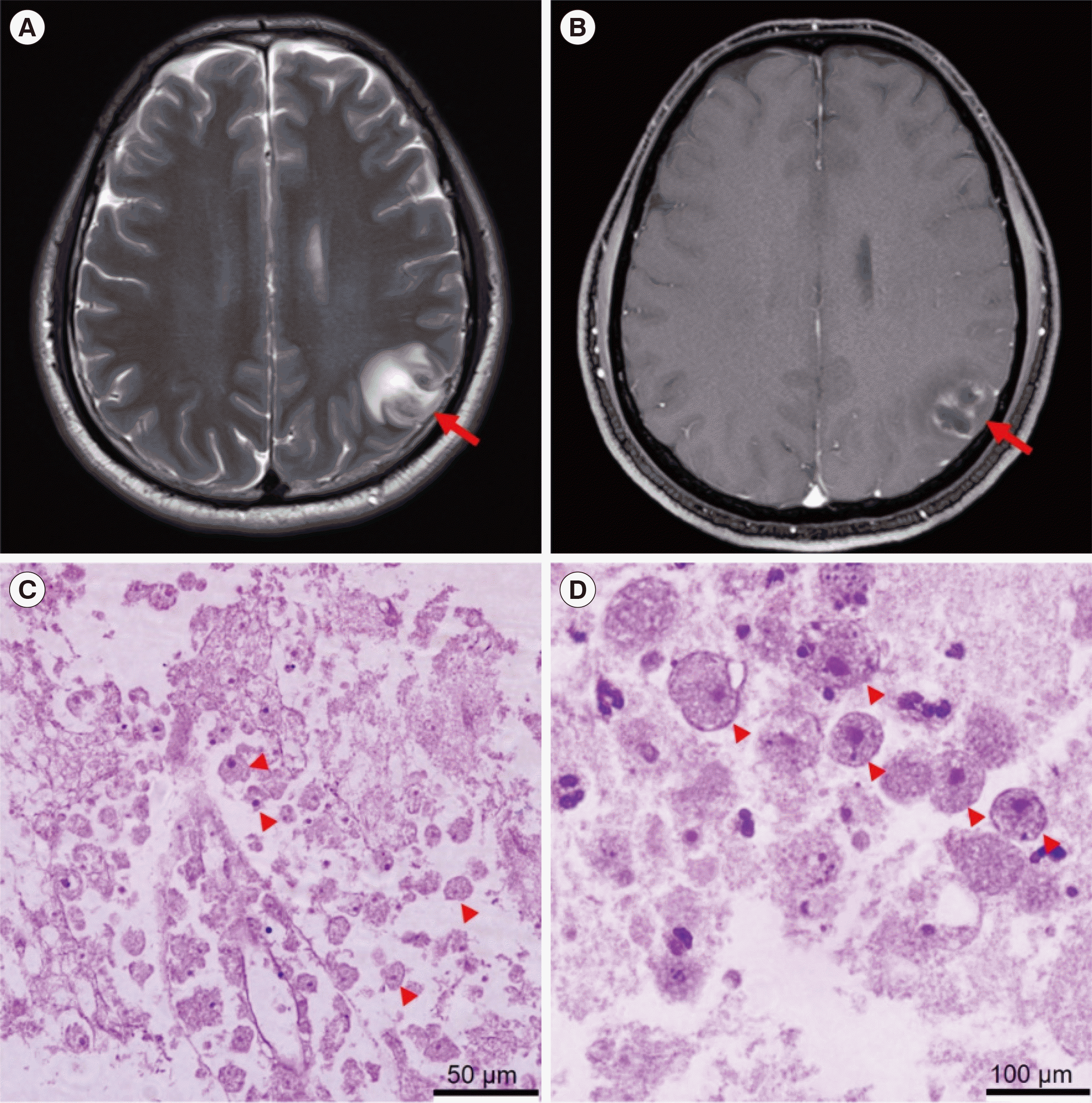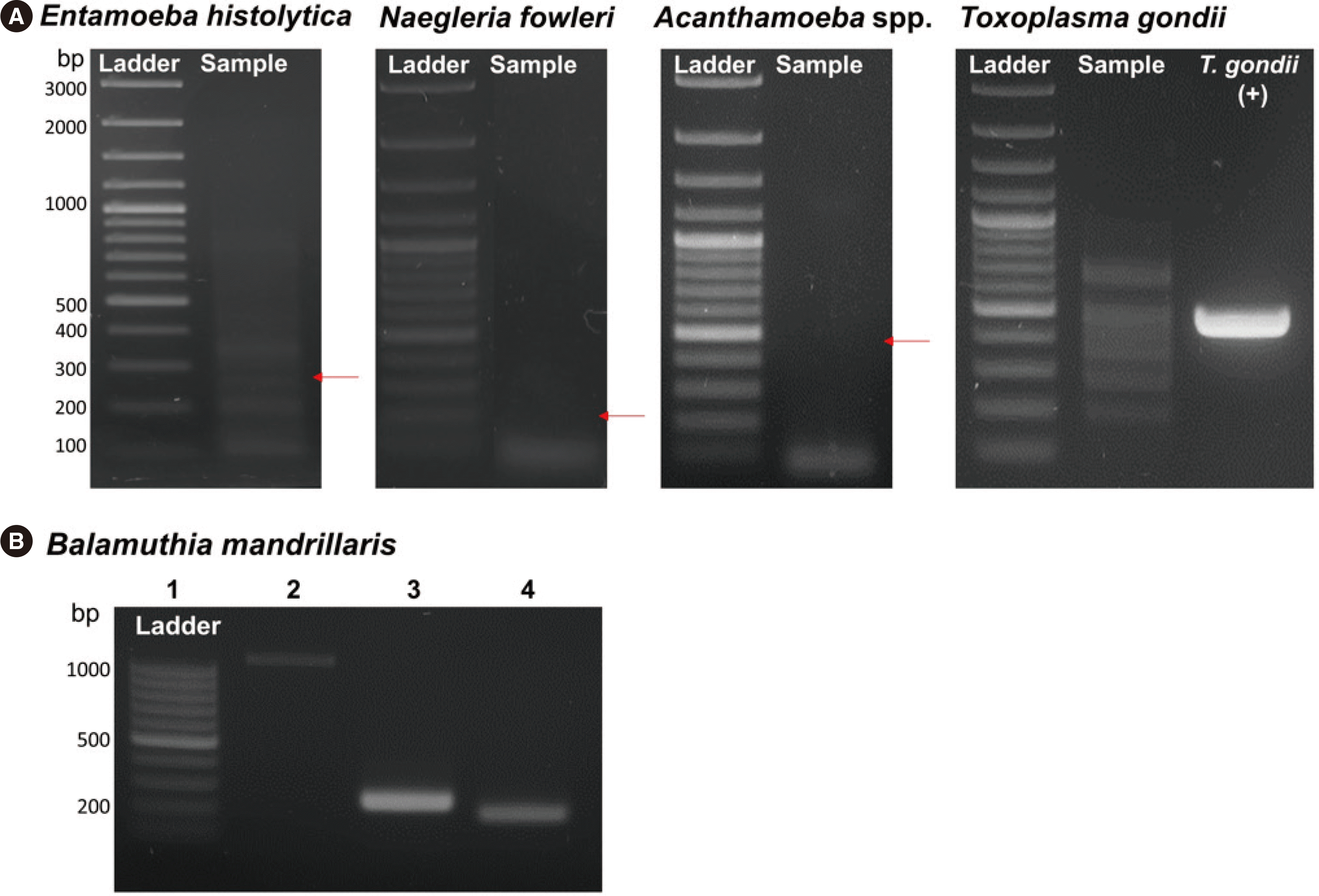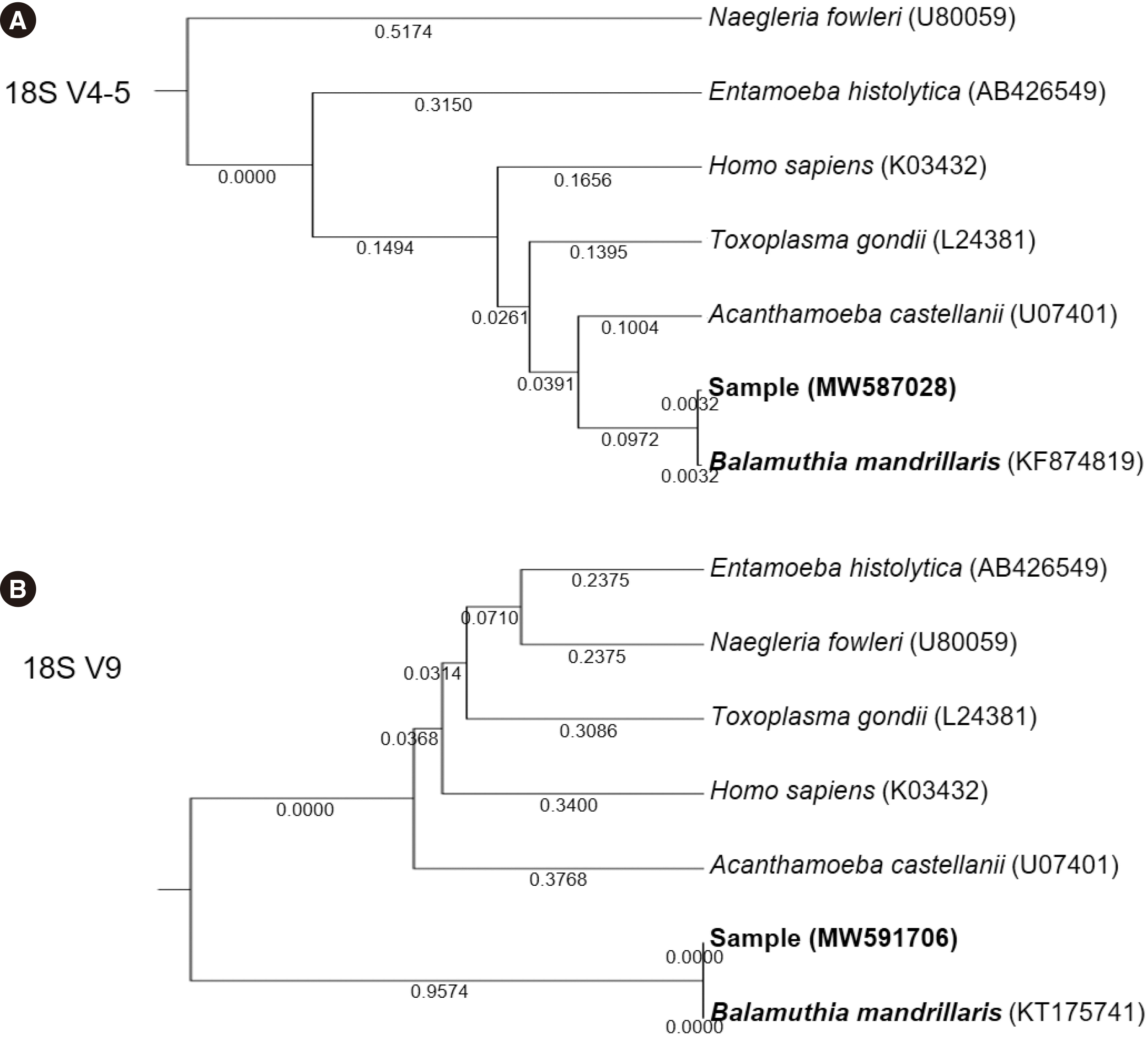1. Wilson MR, Shanbhag NM, Reid MJ, Singhal NS, Gelfand JM, Sample HA, et al. 2015; Diagnos-ing
Balamuthia mandrillaris encephalitis with metagenomic deep sequencing. Ann Neurol. 78:722–30. DOI:
10.1002/ana.24499. PMID:
26290222. PMCID:
PMC4624031.
2. Wilson MR, Naccache SN, Samayoa E, Biagtan M, Bashir H, Yu G, et al. 2014; Actionable diagnosis of neuroleptospirosis by next-generation sequencing. N Engl J Med. 370:2408–17. DOI:
10.1056/NEJMoa1401268. PMID:
24896819. PMCID:
PMC4134948.

3. Popovic A, Bourdon C, Wang PW, Guttman DS, Voskuijl W, Grigg ME, et al. 2018; Design and application of a novel two-amplicon approach for defining eukaryotic microbiota. Microbiome. 6:228. DOI:
10.1186/s40168-018-0612-3. PMID:
30572961. PMCID:
PMC6302507.

5. Kumar S, Stecher G, Li M, Knyaz C, Tamura K. 2018; MEGA X: Molecular Evolutionary Genetics Analysis across computing platforms. Mol Biol Evol. 35:1547–9. DOI:
10.1093/molbev/msy096. PMID:
29722887. PMCID:
PMC5967553.

6. Kang H, Seong GS, Sohn HJ, Kim JH, Lee SE, Park MY, et al. 2015; Effective PCR-based detection of
Naegleria fowleri from cultured sample and PAM-developed mouse. Eur J Protistol. 51:401–8. DOI:
10.1016/j.ejop.2015.07.003. PMID:
26322498.
7. López-López P, Martínez-López MC, Boldo-León XM, Hernández-Díaz Y, González-Castro TB, Tovilla-Zárate CA, et al. 2017; Detection and differentiation of
Entamoeba histolytica and
Entamoeba dispar in clinical samples through PCR-denaturing gradient gel electrophoresis. Braz J Med Biol Res. 50:e5997. DOI:
10.1590/1414-431x20175997. PMID:
28380216. PMCID:
PMC5423754.

8. Lukášová R, Kobédová K, Halajian A, Bártová E, Murat JB, Rampedi KM, et al. 2018; Molecular detection of
Toxoplasma gondii and
Neospora caninum in birds from South Africa. Acta Trop. 178:93–6. DOI:
10.1016/j.actatropica.2017.10.029. PMID:
29092798.
9. Pasricha G, Sharma S, Garg P, Aggarwal RK. 2003; Use of 18S rRNA gene-based PCR assay for diagnosis of
Acanthamoeba keratitis in non-contact lens wearers in India. J Clin Microbiol. 41:3206–11. DOI:
10.1128/JCM.41.7.3206-3211.2003. PMID:
12843065. PMCID:
PMC165372.
10. Booton GC, Carmichael JR, Visvesvara GS, Byers TJ, Fuerst PA. 2003; Identification of
Balamuthia mandrillaris by PCR assay using the mitochondrial 16S rRNA gene as a target. J Clin Microbiol. 41:453–5. DOI:
10.1128/JCM.41.1.453-455.2003. PMID:
12517892. PMCID:
PMC149639.
11. Yamanouchi K, Arima H, Sakamoto Y, Kanto K, Kasai K, Ito K, et al. 2018; First report of the isola-tion of
Balamuthia mandrillaris in the northern region of Japan. Parasitol Res. 117:2895–900. DOI:
10.1007/s00436-018-5980-x. PMID:
29961176. PMCID:
PMC6105249.
12. Wu X, Yan G, Han S, Ye Y, Cheng X, Gong H, et al. 2020; Diagnosing
Balamuthia mandrillaris encephalitis via next-generation sequencing in a 13-year-old girl. Emerg Microbes Infect. 9:1379–87. DOI:
10.1080/22221751.2020.1775130. PMID:
32552393. PMCID:
PMC7473209.
13. da Rocha-Azevedo B, Tanowitz HB, Marciano-Cabral F. 2009; Diagnosis of infections caused by pathogenic free-living amoebae. Interdiscip Perspect Infect Dis. 2009:251406. DOI:
10.1155/2009/251406. PMID:
19657454. PMCID:
PMC2719787.

14. Visvesvara GS. 2010; Free-living amebae as opportunistic agents of human disease. J Neuroparasitology. 1:1–13. DOI:
10.4303/jnp/N100802.

15. Krasaelap A, Prechawit S, Chansaenroj J, Punyahotra P, Puthanakit T, Chomtho K, et al. 2013; Fatal
Balamuthia amebic encephalitis in a healthy child: A case report with review of survival cases. Korean J Parasitol. 51:335–41. DOI:
10.3347/kjp.2013.51.3.335. PMID:
23864745. PMCID:
PMC3712108.
16. Diaz JH. 2011; The public health threat from
Balamuthia mandrillaris in the southern United States. J La State Med Soc. 163:197–204. PMID:
21954652.
17. Schuster FL, Visvesvara GS. 2004; Free-living amoebae as opportunistic and non-opportunistic pathogens of humans and animals. Int J Parasitol. 34:1001–27. DOI:
10.1016/j.ijpara.2004.06.004. PMID:
15313128.

18. Matin A, Siddiqui R, Jayasekera S, Khan NA. 2008; Increasing importance of
Balamuthia mandrillaris. Clin Microbiol Rev. 21:435–48. DOI:
10.1128/CMR.00056-07. PMID:
18625680. PMCID:
PMC2493082.
19. Cary LC, Maul E, Potter C, Wong P, Nelson PT, Given C, et al. 2010;
Balamuthia mandrillaris meningoencephalitis: survival of a pediatric patient. Pediatrics. 125:e699–703. DOI:
10.1542/peds.2009-1797. PMID:
20123772.
20. Deetz TR, Sawyer MH, Billman G, Schuster FL, Visvesvara GS. 2003; Successful treatment of Balamuthia amoebic encephalitis: presentation of 2 cases. Clin Infect Dis. 37:1304–12. DOI:
10.1086/379020. PMID:
14583863.

21. Jung S, Schelper RL, Visvesvara GS, Chang HT. 2004;
Balamuthia mandrillaris meningoencephalitis in an immunocompetent patient: an unusual clinical course and a favorable outcome. Arch Pathol Lab Med. 128:466–8. DOI:
10.5858/2004-128-466-BMMIAI. PMID:
15043486.
22. Martínez DY, Seas C, Bravo F, Legua P, Ramos C, Cabello AM, et al. 2010; Successful treatment of
Balamuthia mandrillaris amoebic infection with extensive neurological and cutaneous involvement. Clin Infect Dis. 51:e7–11. DOI:
10.1086/653609. PMID:
20550438.
23. Orozco LD, Khan MA, Fratkin JD, Hanigan WC. 2011; Asymptomatic aneurysm of the cavernous and supraclinoid internal carotid artery in a patient with
Balamuthia mandrillaris encephalitis. J Clin Neurosci. 18:1118–20. DOI:
10.1016/j.jocn.2010.11.033. PMID:
21652212.
25. Guarner J, Bartlett J, Shieh WJ, Paddock CD, Visvesvara GS, Zaki SR. 2007; Histopathologic spectrum and immunohistochemical diagnosis of amebic meningoencephalitis. Mod Pathol. 20:1230–7. DOI:
10.1038/modpathol.3800973. PMID:
17932496.

26. Schuster FL, Yagi S, Gavali S, Michelson D, Raghavan R, Blomquist I, et al. 2009; Under the radar:
Balamuthia amebic encephalitis. Clin Infect Dis. 48:879–87. DOI:
10.1086/597260. PMID:
19236272.







 PDF
PDF Citation
Citation Print
Print



 XML Download
XML Download